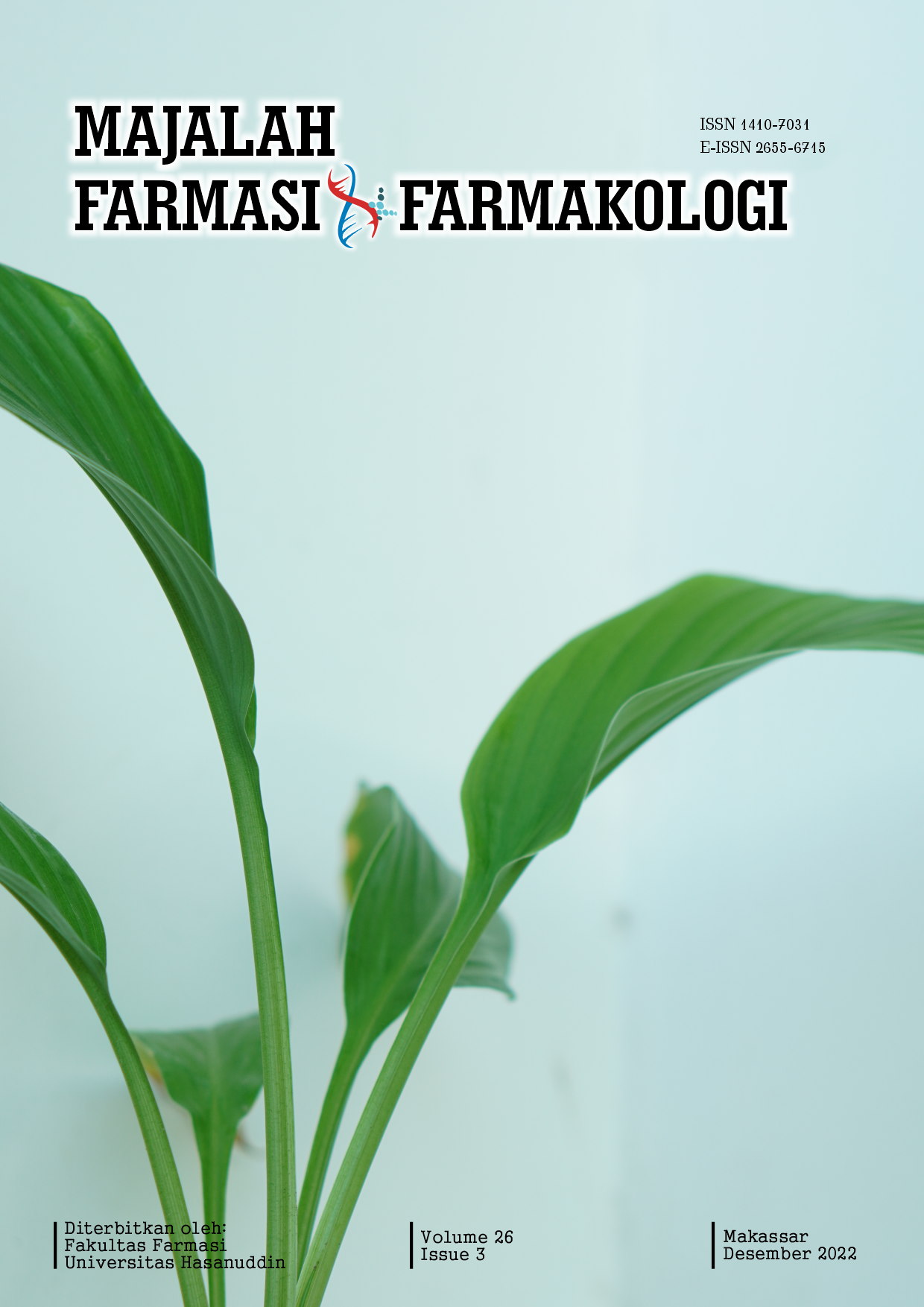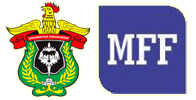ISOLASI α-SELULOSA, PEMBUATAN & KARAKTERISASI MIKROKRISTALIN SELULOSA (MCC) DARI LIMBAH KULIT JERUK BABY (Citrus sinensis)
Keywords:
alfa selulosa, mikrokristalin selulosa, mcc, isolasi selulosa, karakterisasi, kulit jeruk baby, selulosa, mikrokristalin selulosa, kulit jeruk baby, karakterisasi, isolasi selulosaAbstract
Obat memiliki kebermanfaatan yang penting dalam pelayanan kesehatan yang dapat digunakan dalam meningkatkan derajat kesehatan masyarakat. Namun, industri farmasi di Indonesia masih sangat tergantung dengan bahan baku impor. Pemanfaatan buah jeruk baby java masih sangat minim. Hal ini dapat dilihat dari limbah jeruk yang hanya dibuang, yang terdiri dari kulit dan biji. Penelitian ini bertujuan untuk mendapatkan mikrokristalin selulosa dari limbah Kulit Jeruk Baby (MCCKJB), kemudian dilakukan karakterisasi dengan Avicel PH 101 sebagai bahan baku pembanding. Karakterisasi dari MCCKJB terdiri dari uji kualitatif (pemeriksaan organoleptis, identifikasi menggunakan iodinate zinc chloride, pengujian kelarutan, uji pH) dan uji sifat fisik, antara lain: penetapan titik lebur, uji sudut diam, uji laju alir, uji kerapatan, susut pengeringan, & kompresibilitas, dimana setiap uji pada karakterisasi tersebut (uji kualitatif dan uji sifat fisik) akan dibandingkan dengan senyawa pembanding komersial yaitu Avicel PH 101. Berdasarkan hasil penelitian rendemen α-selulosa sebesar 66,75% terhadap serbuk simplisia, rendemen MCCKJB sebesar 82,53% terhadap α-selulosa dan karakterisasi serbuk MCCKJB meliputi reaksi warna, organoleptis, kelarutan, dan pH menunjukkan kemiripan karakteristik dengan Avicel® PH 101 sebagai pembanding, titik lebur 270° C, sudut diam 28,86°, laju alir 1,52 g/s, kerapatan curah 0,349 g/cm3, kerapatan mampat 0,466 g/cm3, susut pengeringan 10,3%, & kompresibilitas 25%. Berdasarkan penelitian yang telah dilakukan, karakteristik serbuk MCCKJB memiliki kemiripan dengan Avicel® PH 101.References
Kemenkes RI. Permenkes RI No 71 Tahun 2013 Tentang Pelayanan Kesehatan Pada Jaminan Kesehatan Nasional. Jakarta: Depkes RI; 2013.
Angga, L. P. Pengaruh Kompetensi Dan Kinerja Karyawan Terhadap Pengembangan Karir Melalui Motivasi Sebagai Variabel Intervening Di Kantor Bpjs Ketenagakerjaan Cabang Madiun (Doctoral dissertation, Universitas Muhammadiyah Ponorogo); 2018.
Spillane, J. J. Ekonomi Farmasi. Yogyakarta: Grasindo; 2010.
Kemenperin. Impor Bahan Baku Obat Tembus Rp 11 Reiliun. Available at http://www.kemenperin.go.id/artikel/2808/Impor-Bahan-Obat Tembus-Rp-11-T; 2012. [Diakses pada 10 Maret 2018].
Ichwani, R. Pemanfaatan Limbah Kulit Jeruk Keprok (Citrus Reticulata Blanco Syn) Sebagai Bahan Penguat Nanokertas Selulosa Bakteri Dari Air Kelapa. Skripsi. Fakultas Matematika dan Ilmu Pengetahuan Alam. Universitas Sumatera Utara; 2013.
Tao Y., Junwen, L., Qinlu, L., and Xiaoqing, J. Penicillium expansum YT01: A Lignocellulose- degrading fungal strain isolatd from China Gaoligong Mountain humus soil. Journal of Biobased Materials and Bioenergy. 2009; 3(4): 348-353.
Oikeh, E. I., Omoregie, E.S., Oviasogie, F.E., & Oriakhi, K. Phytochemical, antimicrobial, and antioxidant activities of different citrus juice concentrates. Food Science and Nutrition. 2015; 4(1): 103–109. doi: 10.1002/fsn3.268.
Liew, Y.J., Zoccola, D., Li, Y., Tambu E., Venn, A.A., Mi, C.T., Ell, Cui, G., et al. Epigenome-associated phenotypic acclimatization to ocean acidification in a reef-building coral. Sci. Adv.2018; 4.
Chau, C.F., & Huang, Y.L. Comparison of the Chemical Composition and Physicochemical Properties of Different Fibers Prepared from the Peel of Citrus sinensis L. cv. Liu-cheng. Journal of Agricultural and Food Chemistry. 2003; 51: 2615-2618. http://dx.doi.org/10.1021/jf025919b
Prastyo, A.M. Karakterisasi Minyak Atsiri Limbah Jeruk Baby Java Dengan Ekstraksi Destilasi Air Dan Uap (Kajian Penundaan Waktu Penyulingan). Sarjana Thesis. Universitas Brawijaya; 2017.
Kalia, S., Kaith, B.S., & Kaur, I. Cellulose-Based Bio- and Nanocomposites: A Review. International Journal of Polymer Science. 2011. Article ID: 837875.
Brinchi, L., Cotana, F., Fortunati. E., Kenny, J.M. Production of nanocrystalline cellulose from lignocellulosic biomass: technology and applications. Carbohydrate Polymer. 2013; 94(1): 154-69. doi: 10.1016/j.carbpol.2013.01.033.
Hindi, Z.S.S. Microcrystalline Cellulose: The Inexhaustible Treasure for Pharmaceutical Industry. Nanoscience and Nanotechnology Research. 2017; 4(1): 17–24. https://doi.org/10.12691/nnr-4-1-3
Lestari, Y.P.I. Optimasi Konsentrasi HCl Pada Proses Hidrolisis Untuk Pembuatan Mikrokristalin Selulosa (MCC) dari Eceng Gondok. Journal Of Innovation Research And Knowledge. 2022; 1(10): 1335-1344,
Hasanah, M., Rizkyah, M.A.P., & Kiki Amelia. Potensi Antioksidan Ekstrak dan Fraksi Daun Eceng Gondok (Eichhornia crassipes (Mart.) Solms) yang Berasal dari Salah Satu Rawa di Palembang, Indonesia. Jurnal Penelitian Sains. 2016; 18(3): 21-119.
Suryadi, H., Lestari, Y.P.I., Mirajunnisa, & Yanuar, A. Potential of Cellulase of Chaetomium globosum for Preparation and Characterization of Microcrystalline Cellulose from Water Hyacinth (Eichhornia crassipes). International Journal of Applied Phamaceutics. 2019; 11(4): 140-146.
Sunardi, Y.S., & Kamilia, M. Sintesis dan Karakterisasi Bioplastik dari Pati Ubi Nagara (Ipomoea batatas L) dengan Kaolin sebagai Penguat. Jurnal Riset Industri Hasil Hutan. 2019; 11: 65-76.
Lestari, Y. P. I., Suryadi, H., Mi’rajunnisa, Mangunwardoyo, W., Sutriyo, & Yanuar, A. Characterization Of Kapok Pericarpium Microcrystalline Cellulose Produced Of Enzymatic Hydrolysis Using Purified Cellulase From Termite (Macrotermes gilvus). International Journal Of Pharmacy And Pharmaceutical Sciences. 2020; 2(3): 7-14.
Rowe, R. C., Paul J.S., & Sian C.O. Handbook of Pharmaceutical Excipients 5th Edition. London and American rowe: Pharmaceutical Press; 2009.
Syam, L.K., Farikha J., Fitriana, & Dian N. Pemanfaatan Limbah Pod Kakao Untuk Menghasilkan Etanol Sebagai Sumber Energi Terbarukan. 2009. Tersedia di : http://repository.ipb.ac.id/handle/1234567 89/20208 [Diakses pada tanggal 22 Juli 2022].
Umar, S. T. Pemanfaatan serat Rami untuk Pembuatan Selulosa. Datin litbang BPP Kemenham RI. 2011. Tersedia di: http://www.balibang.kemhan.go.id/?q=co ntent/pemanfaatan-serat-rami-untuk-pembuatan-selulosa [Diakses tanggal 22 Juli 2022].
Nurhayani, F. Karakterisasi Selulosa Mikrokristal dari Daun Nanas sebagai Eksipien Tablet Metode Kempa Langsung [Skripsi]. Universitas Padjadjaran. Jatinangor; 2008.
Cowd, M.A. Kimia Polimer. Bandung: Institut Teknologi Bandung; 1991.
Fitzpatrick, J. J. & Ahrné, L. Food powder handling and processing: Industry problems, knowledge barriers and research opportunities. Chemical Engineering and Processing: Process Intensification. 2005; 44(2): 209–214. doi: 10.1016/j.cep.2004.03.014.
Geldart, D., Abdullah, E.C., Hasan, A.P., Nwoke L.C., & Wouters I. Characterization of Powder Flowability using Measurement of Angle of Repose. China Particuol. 2006; 4: 104-107.
Mersa, R.N.K. Karakterisasi Selulosa Mikrokristal dari Serbuk Gergaji Kayu Albasia sebagai Eksipien Tablet Metode Kempa Langsung. [Skripsi]. Universitas Padjadjaran. Jatinangor; 2008.
Rafiq, S., Kaul R., Sofi, S.A., Bashir, N., Nazir, F., & Nayik, G.A., Citrus Peel as a Source of Functional Ingredient: A Review, Journal of the Saudi Society of Agricultural Sciences, 2018; 17(4):351-358,
Downloads
Published
Issue
Section
License
Copyright (c) 2022 Majalah Farmasi dan Farmakologi

This work is licensed under a Creative Commons Attribution-NonCommercial 4.0 International License.
The copyright to this article is transferred to Universitas Hasanuddin (UNHAS) if and when the article is accepted for publication. The undersigned hereby transfers all rights in and to the paper including without limitation all copyrights to UNHAS. The undersigned hereby represents and warrants that the paper is original and that he/she is the author of the paper, except for material that is clearly identified as to its original source, with permission notices from the copyright owners where required. The undersigned represents that he/she has the power and authority to make and execute this assignment.
We declare that:
- This paper has not been published in the same form elsewhere.
- It will not be submitted anywhere else for publication prior to acceptance/rejection by this Journal.
- A copyright permission is obtained for materials published elsewhere and which require this permission for reproduction.
Furthermore, I/We hereby transfer the unlimited rights of publication of the above-mentioned paper in whole to UNHAS The copyright transfer covers the exclusive right to reproduce and distribute the article, including reprints, translations, photographic reproductions, microform, electronic form (offline, online) or any other reproductions of similar nature.
The corresponding author signs for and accepts responsibility for releasing this material on behalf of any and all co-authors. This agreement is to be signed by at least one of the authors who have obtained the assent of the co-author(s) where applicable. After submission of this agreement signed by the corresponding author, changes of authorship or in the order of the authors listed will not be accepted.


